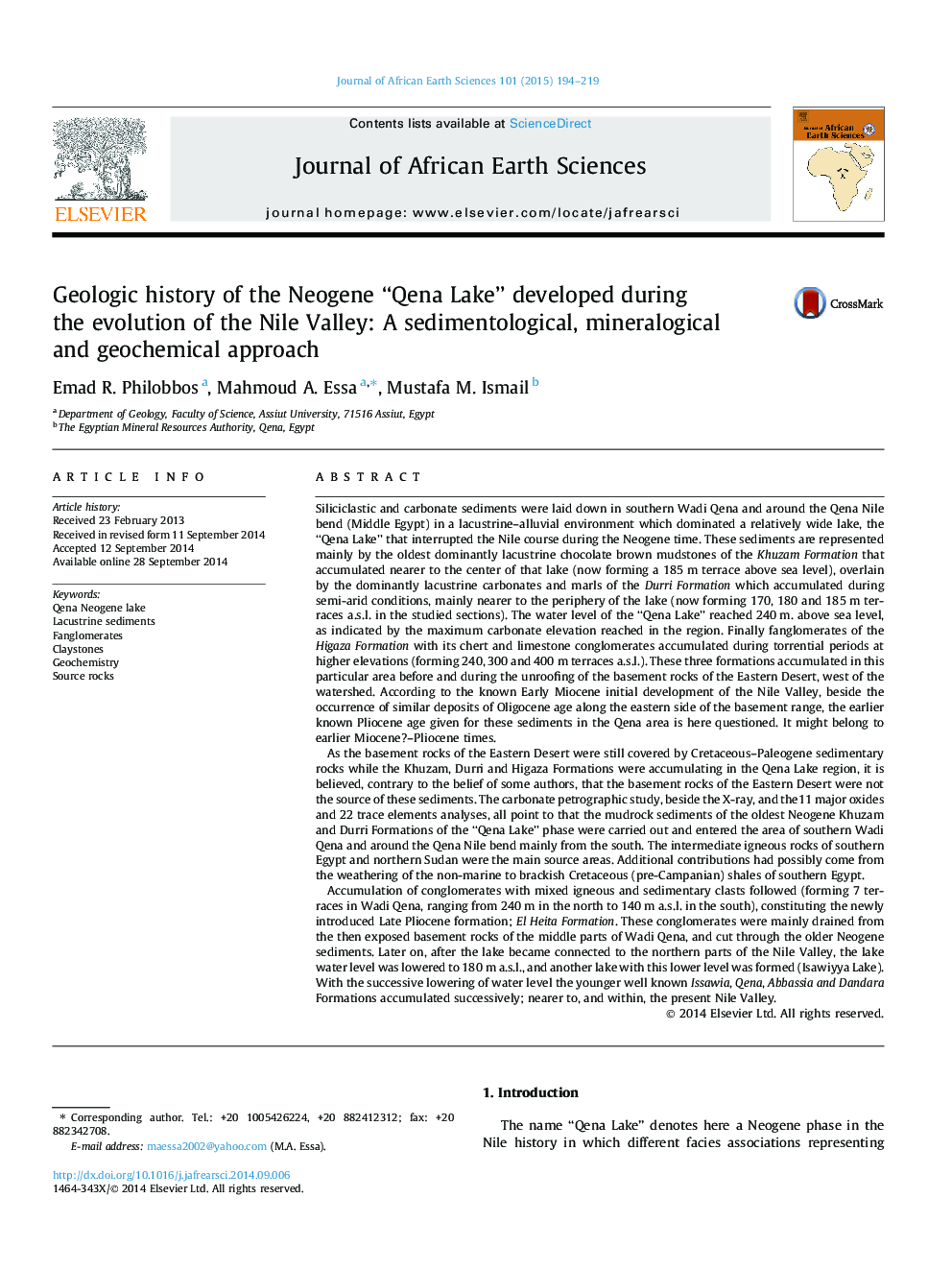| کد مقاله | کد نشریه | سال انتشار | مقاله انگلیسی | نسخه تمام متن |
|---|---|---|---|---|
| 4728670 | 1640206 | 2015 | 26 صفحه PDF | دانلود رایگان |

• “Qena Lake” interrupted the Nile course during the Neogene in Middle Egypt.
• Siliciclastics and carbonates were deposited in a lacustrine–alluvial fan complex.
• Clay mineralogy and geochemistry proved its derivation from south rather than east.
• Sedimentary fanglomerates originating from Eastern Desert capped the lake sediments.
• Stages of Qena Lake development are presented in palaeogeographic maps.
Siliciclastic and carbonate sediments were laid down in southern Wadi Qena and around the Qena Nile bend (Middle Egypt) in a lacustrine–alluvial environment which dominated a relatively wide lake, the “Qena Lake” that interrupted the Nile course during the Neogene time. These sediments are represented mainly by the oldest dominantly lacustrine chocolate brown mudstones of the Khuzam Formation that accumulated nearer to the center of that lake (now forming a 185 m terrace above sea level), overlain by the dominantly lacustrine carbonates and marls of the Durri Formation which accumulated during semi-arid conditions, mainly nearer to the periphery of the lake (now forming 170, 180 and 185 m terraces a.s.l. in the studied sections). The water level of the “Qena Lake” reached 240 m. above sea level, as indicated by the maximum carbonate elevation reached in the region. Finally fanglomerates of the Higaza Formation with its chert and limestone conglomerates accumulated during torrential periods at higher elevations (forming 240, 300 and 400 m terraces a.s.l.). These three formations accumulated in this particular area before and during the unroofing of the basement rocks of the Eastern Desert, west of the watershed. According to the known Early Miocene initial development of the Nile Valley, beside the occurrence of similar deposits of Oligocene age along the eastern side of the basement range, the earlier known Pliocene age given for these sediments in the Qena area is here questioned. It might belong to earlier Miocene?–Pliocene times.As the basement rocks of the Eastern Desert were still covered by Cretaceous–Paleogene sedimentary rocks while the Khuzam, Durri and Higaza Formations were accumulating in the Qena Lake region, it is believed, contrary to the belief of some authors, that the basement rocks of the Eastern Desert were not the source of these sediments. The carbonate petrographic study, beside the X-ray, and the11 major oxides and 22 trace elements analyses, all point to that the mudrock sediments of the oldest Neogene Khuzam and Durri Formations of the “Qena Lake” phase were carried out and entered the area of southern Wadi Qena and around the Qena Nile bend mainly from the south. The intermediate igneous rocks of southern Egypt and northern Sudan were the main source areas. Additional contributions had possibly come from the weathering of the non-marine to brackish Cretaceous (pre-Campanian) shales of southern Egypt.Accumulation of conglomerates with mixed igneous and sedimentary clasts followed (forming 7 terraces in Wadi Qena, ranging from 240 m in the north to 140 m a.s.l. in the south), constituting the newly introduced Late Pliocene formation; El Heita Formation. These conglomerates were mainly drained from the then exposed basement rocks of the middle parts of Wadi Qena, and cut through the older Neogene sediments. Later on, after the lake became connected to the northern parts of the Nile Valley, the lake water level was lowered to 180 m a.s.l., and another lake with this lower level was formed (Isawiyya Lake). With the successive lowering of water level the younger well known Issawia, Qena, Abbassia and Dandara Formations accumulated successively; nearer to, and within, the present Nile Valley.
Journal: Journal of African Earth Sciences - Volume 101, January 2015, Pages 194–219